engine AUDI A4 AVANT 2008 Manual PDF
[x] Cancel search | Manufacturer: AUDI, Model Year: 2008, Model line: A4 AVANT, Model: AUDI A4 AVANT 2008Pages: 368, PDF Size: 46.19 MB
Page 256 of 368
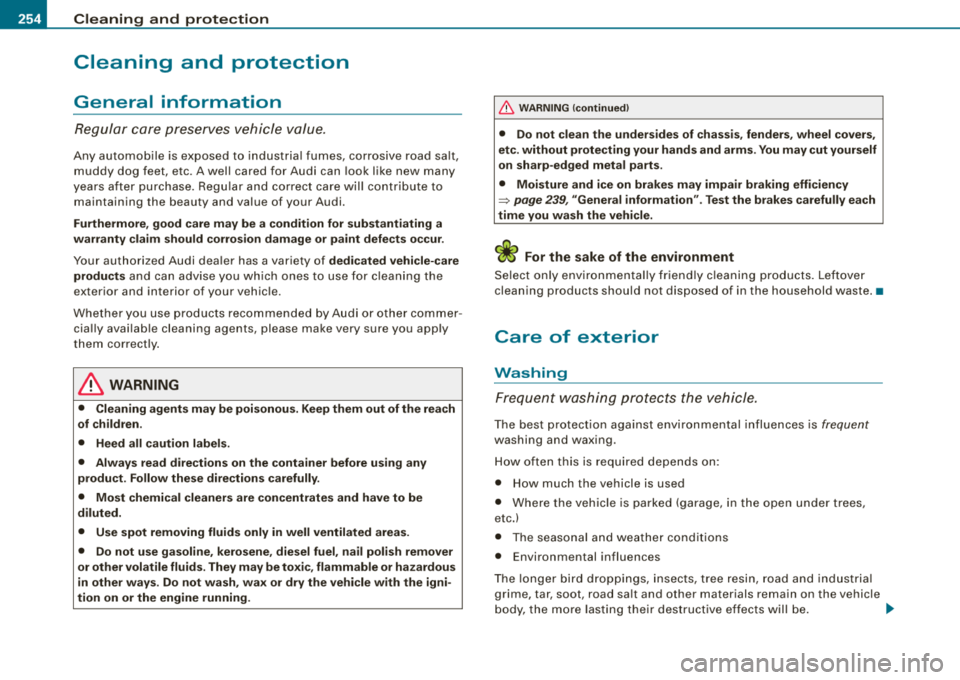
___ C_ le_ a_n _ i_ n_ g~ a_ n_d~ p_ ro_ t_e _c _t_ i_o _n _____________________________________________ _
Cleaning and protection
General information
Regular care preser ves vehicle value.
Any automob ile is exposed to industria l fumes, corrosive road salt,
muddy dog feet, etc. A well cared for Audi can look like new many
yea rs a fter purc hase. Regu lar a nd co rrec t care wil l co ntribu te to
maintaining the beauty and value of your Audi.
Furthermore , good care may be a condition for substantiating a
warranty claim should corrosion damage or paint defe cts occur .
Your authorized Audi dea ler has a variety of dedi cated vehicle-care
product s
and can advise yo u wh ic h ones to use for c lea nin g t he
e xterior and interior of your vehic le.
W hethe r you use p roducts reco mm end ed b y Audi o r other c omm er
cia lly avai lab le cleaning agents , please make very sure you apply
t hem correct ly .
& WARNING
• Cleaning agents may be poisonous. Keep them out of the rea ch
of children .
• Heed all caution label s.
• Always read directions on the container before using any
produ ct. Follo w the se dire ction s carefully.
• Most chemical cleaners are con centrates and have to be
diluted .
• Use spot removing fluids only in well ventilated areas .
• Do not use gasoline , kerosene , diesel fuel, nail polish remover
or other volatile fluids. They may be toxic , flammable or hazardous
in other ways. Do not wash , wax or dry the vehicle with the igni
tion on or the engine running.
& W ARNIN G (continued )
• Do not clean the undersides of chassis , fenders , wheel cover s,
etc . without protecting your hands and arms. You may cut yourself
on sharp -edged metal parts .
• Moisture and ice on brakes may impair braking efficiency
=> page 239 , "General information ". Test the brakes carefully each
time you wash the vehicle.
cleaning products should not disposed of in the household waste. •
Care of exterior
Washing
Frequent wash in g pro te ct s the vehi cle.
Th e bes t protect ion aga inst enviro nmental in fl uences is frequent
washing and waxing .
Ho w o ften t his is required depends on:
• How much t he vehicle is used
• Where the vehic le is pa rked (garage, i n the ope n under t rees,
etc.)
• The seaso nal and wea the r cond itions
• Environmental influences
T he lo n ger bir d dropp ings, i nsec ts, tree resin, road and ind ust ria l
grime, tar, soot, road salt and other materials remain on the vehicle
b ody, the m ore lasti ng the ir des tru cti ve effects will be . .,.
Page 258 of 368
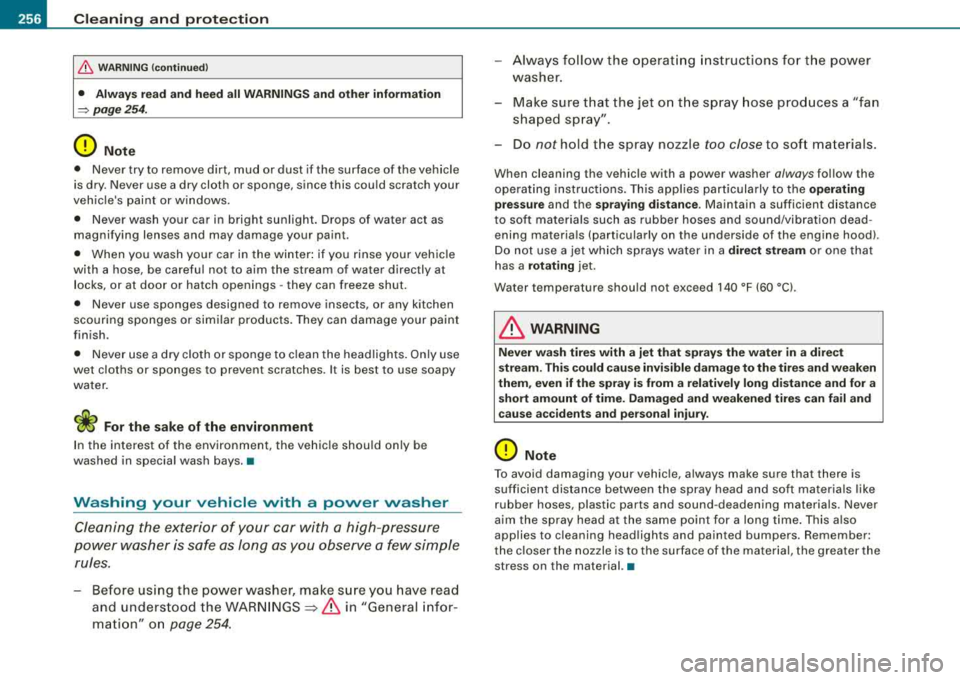
___ C_ le_a_ n_in ~ g_ a_n _ d_ p_ ro_ t_e _c _t _io _ n ___________________________________________ _
&, WARNING (continued )
• Always read and heed all WARNINGS and other information
=> page 254 .
0 Note
• Never try to remove dirt, mud or dust if the surface of t he veh icle
is dry. Never use a dry cloth or sponge, since this cou ld scratch your
veh ic le's paint or w indows .
• N ever wash your car in bright sunlight . Drops of water act as
magnifying lenses and may damage your paint.
• When yo u wash your ca r in the winter : if you rinse you r ve hicle
with a hose, be carefu l not to aim the stream of water directly at
l ocks, or at door or hatch openings -they can freeze shut.
• Never use sponges designed to remove insects, or any kitchen
scouring spo nges or similar pr oducts. They can damage yo ur paint
finish .
• Never use a dry cloth or spo nge t o clean the head ligh ts . O nly use
wet cloths or sponges to prevent scratches . It is best to use soapy
water.
<£> For the sake of the environment
I n the interest of the environment, the vehic le shou ld on ly be
washed in specia l wash bays. •
Washing your vehicle with a power washer
Cleaning the exterior of your car w ith a high -p ressure
po wer w asher is s afe as l ong as you observe a few simple
rules .
-Before us ing the power washer, make s ure you have rea d
and unders tood the
WAR NINGS:=> & in "General infor
mati on" o n
page 254.
-Always follow the operating instru ctio ns fo r th e p owe r
w ash er.
-Make sure t hat t he jet o n the spray hose pro duces a "fan
sha ped sp ray".
-Do not hold the spray nozzle too close to soft ma terials.
When cleaning the vehicle w ith a power washer always follow the
opera tin g instruc tions. Th is appl ies partic ula rly to the
operating
pre ssure
and t he spraying distance . Maintain a sufficient distance
t o so ft m ateria ls such as rubber hoses and sound/vib rat ion dead
ening materia ls (particularly on the underside of the engine hood).
D o no t use a jet w hich sprays wa ter in a
direct stream o r one tha t
has a
rotating j et .
Water temperature shou ld not exceed 140 °F (60
°CJ.
& WARNING
Never wash tires with a jet that sprays the water in a direct
s tream . This could cause invi sible damage to the tire s and weaken
them , even if the spray is from a relatively long distan ce and for a
s hort amount of time . Damaged and weakened tires c an f ail and
ca use ac cidents and personal injur y.
0 Note
To avoid damaging your vehic le, always make sure that there is
su fficient dis tance between the spray head and so ft m ater ia ls l ike
rubber hoses , plastic parts and sound -deadening materials . Never
a im the spray head a t the same p oint for a l ong time . This a lso
applies to cleaning head lights and painted bumpers . Remember:
t he c loser t he n ozzle is to the surface o f the mate rial, the greater the
stress on the material. •
Page 267 of 368

_______________________________________________ C_l_ e _a_ n_ in---= g'-- a_n_ d
_.:.. p_r_o _ t_ e_ c_ t·_
1o _ n __ l9III
Safety belts
Only well-maintained safety belts work reliably when
needed.
- Keep belts clean.
- For cleaning, use a mild soap and water solution. Let
belts dry thoroughly and away from direct sunlight.
- Do not allow inertia reel safety belts to retract before
they are completely dry.
- Check the condition of your safety belts
regularly.
Heavily soiled safety belts may not retract properly.
& WARNING
Damaged safety belts can break in a crash.
• Anything that might damage your safety belts could mean that
you and your passengers would not be adequately protected in an
accident.
• Safety belt performance depends on correct installation. Never
remove belts from the vehicle to clean them.
• Do not use chemical cleaning agents, bleach or dyes. They have
corrosive properties which weaken the webbing.
• When cleaning your safety belts, inspect them for damage. If
you discover damage, see your Audi dealer.
• Always read and heed all WARNINGS and the information
=> page 254. •
Engine compartment
Be especially careful when cleaning the engine compart
ment.
Always switch off the ignition before cleaning the engine => &.
Plenum panel
Remove leaves from the plenum panel in front of the windshield
under the engine hood. This prevents the water drain holes from
becoming blocked, and it prevents debris from entering the vehicle
interior through the heating and ventilation ducts .
Corrosion protection
The engine compartment and transmission have been corrosion
protected at the factory.
Good anti-corrosion treatment is very important, particularly in the
winter. If the vehicle is frequently driven on salt treated roads, the
entire engine compartment and plenum panel should be thor
oughly cleaned at the end of winter and retreated to prevent salt
damage. At the same time, the underside of the vehicle should be
washed as well.
If the engine compartment is cleaned at any time with grease
removing solutions
21 , or if you have the engine washed , the anti
corrosion treatment is almost always removed as well. It is therefore
essential to have a long-lasting corrosion protection reapplied to all
surfaces, seams, joints and components in the engine compart
ment.
& WARNING
Be aware: the engine compartment of any motor vehicle is a
potentially hazardous area.
• Before working in the engine compartment, be sure to read the
information
=> page 265 . .,,_
21 Use only the corr ect cleaning solutions. Never use gasoline or diesel fuel.
Vehicle care
Page 268 of 368
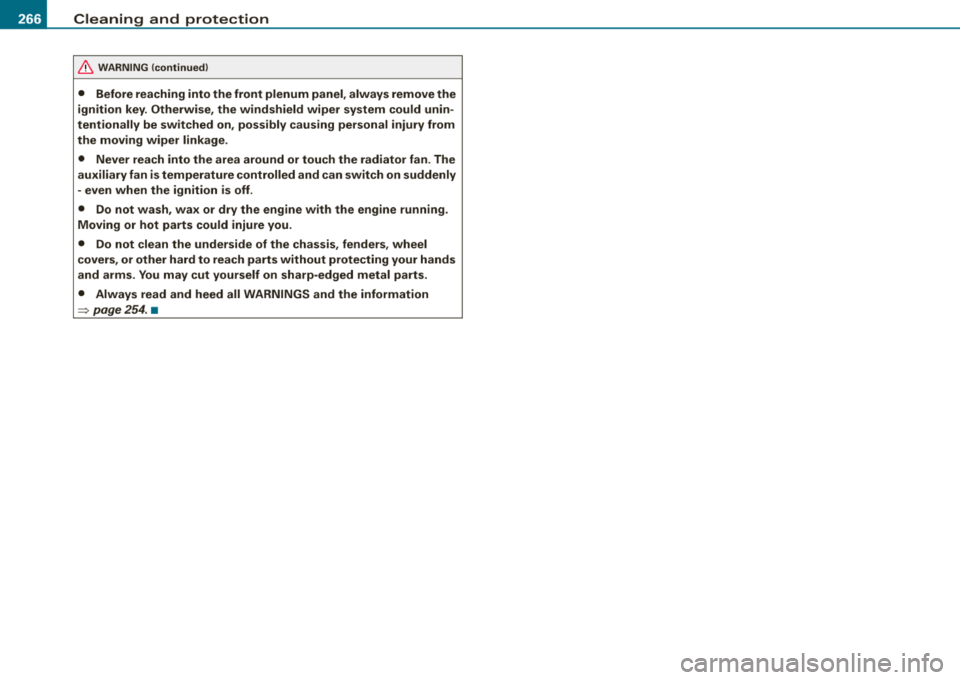
___ C_ le_a_ n_in ~ g_ a_n _ d_ p_ ro_ t_e _c _t _io _ n ___________________________________________ _
&, WARNING (continued)
• Before reaching into the front plenum panel, always remove the
ignition key. Otherwise, the windshield wiper system could unin
tentionally be switched on , possibly causing personal injury from
the moving wiper linkage .
• Never reach into the area around or touch the radiator fan. The
auxiliary fan is temperature controlled and can switch on suddenly
- even when the ignition is off.
• Do not wash, wax or dry the engine with the engine running .
Moving or hot parts could injure you .
• Do not clean the underside of the chassis , fenders , wheel
covers, or other hard to reach parts without protecting your hands
and arms. You may cut yourself on sharp-edged metal parts .
• Always read and heed all WARNINGS and the information
~ page 254. •
Page 269 of 368
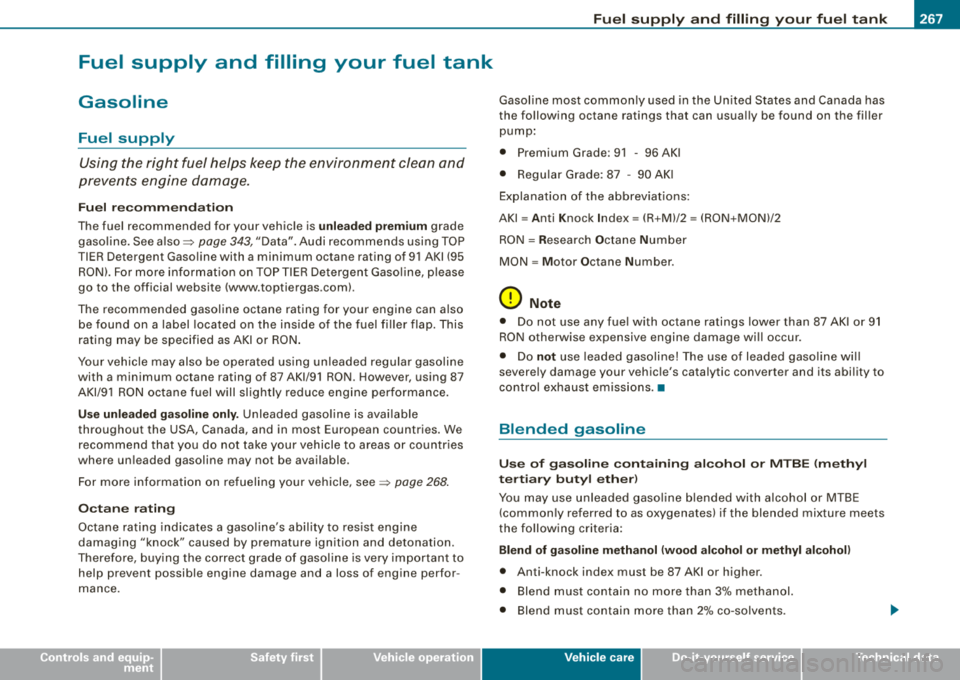
Fuel supply and filling your fuel tank
Gasoline
Fuel supply
Using the right fuel helps keep the environment clean and
prevents engine damage.
F u el re comm end ati on
The fuel recommended for your vehic le is unle ad ed pr em ium grade
gaso line . See
a lso => page 343, "Data". Audi recommends using TOP
TIER Detergent Gaso line with a minimum octane rating of 91 AKI (95
RON). For more informat ion on TOP TIER Detergent Gaso line, p lease
go to the official website (www .toptiergas .com) .
The recommended gasoline octane rating for your engine can also be found on a label located on the ins ide of the fuel fi ller flap. This
rating may be specified as A KI o r RON .
Your vehicle may also be operated us ing u nleaded regular gasoline
with a minimum octane rating of 87 AKl/91 RO N. However, using 87
A Kl/9 1 RON octane fuel w ill sl ight ly reduce engine performance.
U se unleaded gasoline only. Unleaded gaso line is avai lable
throughout the USA, Canada, and in most European countries. We
recommend that you do not take your vehicle to areas or countr ies
where un leaded gasoline may not be available .
For more informati on on refueling yo ur vehicle,
see => page 268 .
Octan e ra ting
Octane rating indicates a gaso line's abil ity to res ist engine
damaging
" k nock" caused by premature ign ition and detonation.
Therefore, buying t he correct grade of gasoline is very i mpo rtant to
help prevent possible engine damage and a loss of engine perfor
mance.
Fu el supply and fillin g your fu el tank
Gasol ine most common ly used in the Un ited States and Canada has
the fo llowing octane ratings that can usua lly be found on the filler
pump :
• Premium Grade : 91 - 96 AKI
• Regu lar Grade: 87 -90 AKI
Explanation of t he abbrev iat ions:
AKI = Anti Knock Index= (R +Ml/2 = (RO N+MON)/2
RO N= R esearc h Octane Num ber
MON = M otor Octane Number .
0 Note
• Do n ot use any fue l with octane ratings l ower than 87 AKI o r 91
RO N otherwise expensive engine damage wi ll occur.
• Do
not use leaded gasoline! The use of leaded gaso line wi ll
severe ly damage your vehic le's catalytic converter and its abi lity to
co ntr ol exhaus t em issions. •
Blended gasoline
Use of ga soline containing alcohol or MTBE (m ethyl
tert iary but yl ether )
You may use unleaded gaso line blended with alcohol or MTBE
(commonly referred to as oxygenates) if the blended mixture meets
the fo llow ing criteria:
Blend of ga soline meth anol (wood alcohol or methyl alc ohol)
• Anti-knock index must be 87 AKI or higher .
• Blend must contain no more than 3% methanol.
• Blend must contain more than 2% co-solvents.
Vehicle care
Page 270 of 368
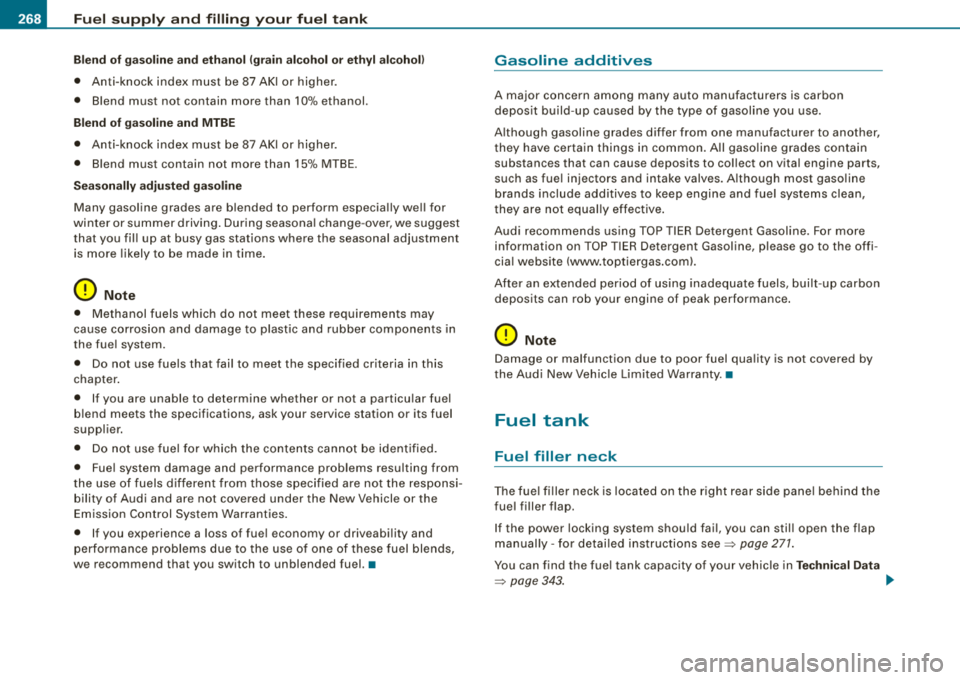
Fue l su pply and fillin g yo ur fu el tank
Ble nd of g aso line and ethanol (grain alco hol or ethyl alco ho l!
• Anti-knock index must be 87 AKI or higher.
• Blend must not contain more than 10% ethanol.
Blend of ga solin e and MTBE
• Anti-knock index must be 87 AKI or higher.
• Blend must contain not more than 15% MTBE.
Sea sonall y adj usted ga soline
Many gasoline grades are blended to perform especia lly we ll for
winter or summer drivi ng . Dur ing seasona l change -over, we suggest
that you fil l up at busy gas stations where the seasonal adjustment
is more likely to be made in time .
0 Note
• Methanol fuels which do not meet these requirements may
cause corrosion and damage to plastic and rubber components in
the fue l system.
• Do not use fuels that fail to meet the specified criteria in this
chapter .
• If you are unable to determine whether or not a particu lar fuel
b lend meets the specifications, ask your service station or its fuel
supplier.
• Do not use fuel for w hich the contents ca nnot be identified.
• Fue l system damage and performance problems resulting from
t he use of fuels different fro m those specified are no t the responsi
bility of Audi and are not covered under the New Vehicle or the
Em ission Control System Warranties .
• If you experience a loss of fue l economy or driveabi lity and
performa nce problems due to the use of o ne of these fuel blends,
we recommend that you switch to unblended fuel. •
Gasoline additives
A major concern among many auto manufacturers is carbon
depos it build-up caused by the type of gasoline you use.
A lthough gasoline grades differ from one manufacturer to another,
they have certain things in common. All gaso line grades contain
substances that can cause deposits to co llect on vital engine parts,
such as fue l injectors and intake valves. A lthough most gaso line
brands include additives to keep engine and fue l systems clean,
they are not equal ly effective .
Audi reco mmends using TOP TIER De tergen t Gasoline. For more
information on TOP T IER Detergent Gasoline, please go to the offi
cia l website (www.toptie rgas .com).
After an extended period of using inadequate fuels, built-up carbon
deposits can rob your engine of peak performance .
(D Note
Damage or malfunction due to poor fuel qua lity is not covered by
the Aud i New Veh ic le Limited Warranty. •
Fuel tank
Fuel filler neck
The fue l fi ller neck is located o n the r ight rear side pane l be hin d the
fuel filler flap.
I f the power locking system shou ld fail, you can stil l open the flap
manual ly - for detai led instructions
see=> page 271 .
You can find the fuel tank capacity of your vehicle in Techni cal Dat a
=> page 343. ~
Page 272 of 368
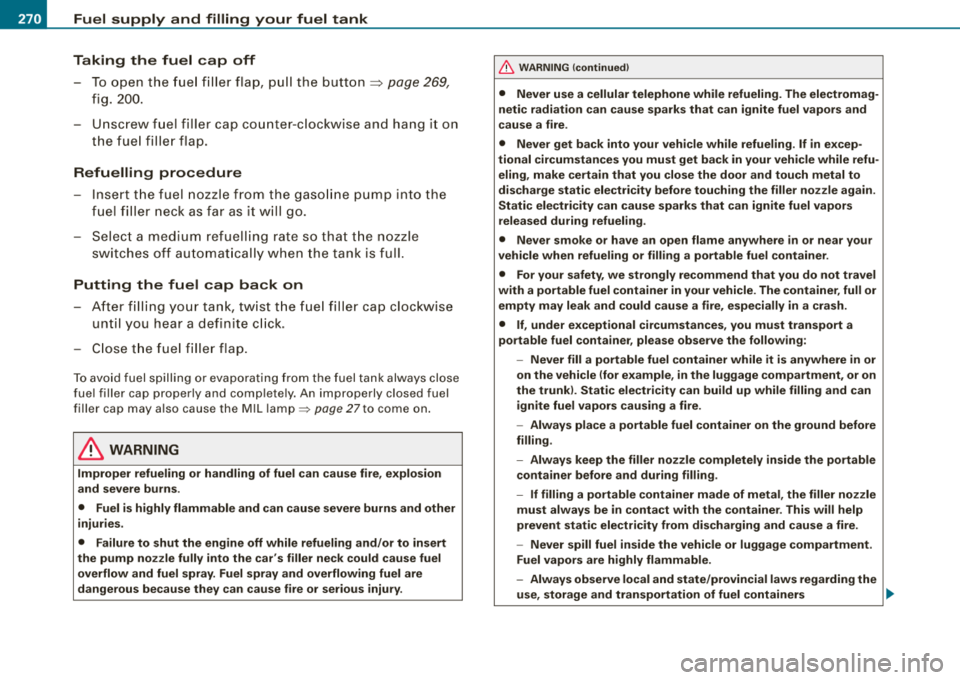
Fuel supply and filling your fuel tank
Taking the fuel cap off
- To open the fuel filler flap, pull the button~ page 269,
fig. 200.
- Unscrew fuel filler cap counter-clockwise and hang it on the fuel filler flap.
Refuelling procedure
- Insert the fuel nozzle from the gasoline pump into the
fuel filler neck as far as it will go.
- Select a medium refuelling rate so that the nozzle
switches off automatically when the tank is full.
Putting the fuel cap back on
- After filling your tank, twist the fuel filler cap clockwise
until you hear a definite click.
- Close the fuel filler flap.
To avoid fuel spilling or evaporating from the fuel tank always close
fuel filler cap properly and completely. An improperly closed fuel
filler cap may also cause the MIL lamp => page 27to come on.
& WARNING
Improper refueling or handling of fuel can cause fire, explosion
and severe burns .
• Fuel is highly flammable and can cause severe burns and other
injuries.
• Failure to shut the engine off while refueling and/or to insert
the pump nozzle fully into the car's filler neck could cause fuel
overflow and fuel spray. Fuel spray and overflowing fuel are
dangerous because they can cause fire or serious injury.
& WARNING (continued)
• Never use a cellular telephone while refueling. The electromag
netic radiation can cause sparks that can ignite fuel vapors and
cause a fire .
• Never get back into your vehicle while refueling. If in excep
tional circumstances you must get back in your vehicle while refu
eling, make certain that you close the door and touch metal to
discharge static electricity before touching the filler nozzle again .
Static electricity can cause sparks that can ignite fuel vapors
released during refueling .
• Never smoke or have an open flame anywhere in or near your
vehicle when refueling or filling a portable fuel container.
• For your safety, we strongly recommend that you do not travel
with a portable fuel container in your vehicle. The container, full or
empty may leak and could cause a fire, especially in a crash.
• If, under exceptional circumstances, you must transport a
portable fuel container, please observe the following:
- Never fill a portable fuel container while it is anywhere in or
on the vehicle (for example, in the luggage compartment, or on
the trunk). Static electricity can build up while filling and can
ignite fuel vapors causing a fire.
- Always place a portable fuel container on the ground before
filling.
- Always keep the filler nozzle completely inside the portable container before and during filling.
- If filling a portable container made of metal, the filler nozzle must always be in contact with the container. This will help
prevent static electricity from discharging and cause a fire.
- Never spill fuel inside the vehicle or luggage compartment .
Fuel vapors are highly flammable.
- Always observe local and state/provincial laws regarding the
use, storage and transportation of fuel containers
~
Page 273 of 368

Fuel supply and filling your fuel tank ------------ -=--=---=-----:::,.......c._ _ __,
/b, WARNING (continued)
-Make certain the fuel container meets industry standards
(ANSI / ASTM F852-861.
0 Note
If any fuel has spilled onto the car, it should be removed immedi
ately to prevent damage to the paint.
ffi For the sake of the environment
As soon as the correctly operated no zzle switches off automatically
for the first time, the tank is full. Do not try to add more fuel because
fu el may spill out . In addition, the expansion space in the fuel tank
will be filled
-causing the fuel to overflow when it becomes warm
and pollute the environment.
[ i] Tips
• Running your engine while refuelling may cause vapors to
escape or even fuel to spill out of the tank. This would then shut off
the fuel nozzle before the tank is full.
• Do not refuel your vehicle with the ignition switched on. The fuel
gauge may o therwise not indicate the correc t fuel level after
refuelling. •
Unlocking the fuel filler f lap by hand
You can open the fuel filler flap by hand if the power
locking system should fail.
Fig . 202 Inside the
luggage compartment:
Opening the fuel filler
flap by hand
If the power locking system should fail, you can still open
the flap manually:
- Open the rear lid.
- Open the round cover in the side trim panel on the right
side.
- Pull the actuator in the direction of arrow to release the
fuel filler flap
=> fig. 202.
- Open the fuel filler flap. •
Vehic le care irechnical data
Page 274 of 368

-Checking and filling Pll':f..._--=--=--------------
Checking and filling
Engine hood
Releasing the engine hood
The engine hood is released from inside the vehicle.
Fig. 203 Driver's side
footwell: engine hood
release lever
- Pull the release lever on the left under the instrument
panel=> fig. 203 in the direction of the arrow.
The hood pops up slightly under spring pressure. •
Opening the engine hood
Fig. 204 Release lever
under the hood
Before opening the engine hood, make sure that the wind
shield wipers are flat against the windshield. Otherwise,
they could damage the paint on the hood.
Lift the hood
slightly=> ,&.
- Pull the release under the hood => fig. 204. This releases
the catch.
- Open the hood all the way.
The hood is kept in the open position by a gas strut.
& WARNING
Hot engine coolant can burn you.
• To reduce the risk of being burned, never open the hood
if you
see or hear steam or coolant escaping from the engine compart-.,..
Page 275 of 368

Checking and filling -
-----------------------------==--------=--
& WARNING (continued)
ment. Wait until no steam or coolant can be seen or heard before
carefully opening the hood.
•
Closing the engine hood
- Pull the hood down until the pressure from the strut is
reduced.
- Let the hood
drop down and latch in place. Do not try to
push
it shut; it may fail to engage =:>& .
& WARNING
A hood that is not completely latched could fly up and block your
view while driving.
• When you close the engine hood, check it to make sure the
safety catch has properly engaged. The hood should be flush with
the surrounding vehicle body parts.
• If you notice while driving that the hood is not secured prop
erly, stop at once and close it. •
Working in the engine compartment
Be especially careful whenever you work in the engine
compartment.
Whenever you must perform any work in the engine compartment,
for example checking and filling different fluids, there is a risk of
injury, burns and accidents. To prevent personal injury always
observe the following WARNINGS . The engine compartment of any
vehicle is a hazardous area
=> & .
• I I • • I
& WARNING
To help avoid injury, before you check anything under the hood:
• Turn off the engine.
• Remove the ignition key .
• Apply the parking brake.
• Move selector lever of automatic transmission to
"P" (Park);
put manual transmission in Neutral.
• Always let the engine cool down. Hot components will burn
skin on contact.
• To reduce the risk of being burned, never open the hood if you
see or hear steam or coolant escaping from the engine compart
ment. Wait until no steam or coolant can be seen or heard before
carefully opening the hood.
• Keep children away from the engine compartment.
• Never spill fluids on hot engine components. They can cause a
fire.
• Never touch the radiator fan. The auxiliary electric fan is
temperature controlled and can switch on suddenly.
• Never open the coolant reservoir cap when the engine is still
warm . The coolant system is pressurized and hot coolant could
spray out.
• Protect your face, hands and arm from steam or hot engine
coolant by placing a thick rag over the cap when you open the
coolant reservoir .
• If work on the fuel system or the electrical system is necessary: -Always disconnect the battery.
- Never smoke or work near heaters or open flames. Fluids in
the engine compartment could start a fire .
- Keep an approved fire extinguisher immediately available.
• To avoid electrical shock and personal injury while the engine
is running or being started, never touch:
- Ignition cables
.,_
Vehicle care